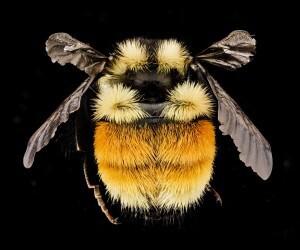- February 07, 2015
- By Karen Shih ’09
“Animals and plants, they just don’t like to be counted,” Sam Droege ’80 observes. That hasn’t stopped the eccentric biologist from trying.
He has spent 13 years at the U.S. Geological Survey’s Patuxent Wildlife Refuge Center working to collect samples of all 4,000 species of North American bees, most of which are the size of a grain of rice and nearly indistinguishable from each other.
His efforts will help establish the health of the continent’s native bee population. While it’s well-documented how colony collapse, parasites and disease have decimated honey bees and jeopardized the long-term outlook for fruit and vegetable production, native bees are also important pollinators, evolving in tandem with North American plants like summer squash. But nobody knows how many are out there, how they’re doing or what their future looks like.
When Droege started his latest volunteer-based project (he’s previously counted crickets and frogs), he thought he’d send off collected samples to experts for identification and quickly get some answers. But it turned out there’s so little data on them—10 percent don’t even have names—that he had to become that expert.
“I’ve painted myself into a bee corner,” says Droege, who has collected about 3,000 species and 400,000 specimens so far.
His first love, however, was a different winged creature: birds. He virtually memorized his grandfather’s 1915 bird book to identify species near his Hyattsville, Md., home. Eventually, that led to the bird club at Patuxent, where the shy, self-proclaimed “nerd child” thought, “Oh my God, I’ve found my people.”
He came to UMD with that passion for all things that fly, crawl and scamper, learning to identify and gather everything from small mammals to insects (he amassed the second-largest collection in UMD history).
As a graduate student at SUNY College of Environmental Science and Forestry in Syracuse, he adopted a sustainable lifestyle long before it was trendy. When his funding got cut, he moved into his office, ate roadkill and trapped animals like squirrels and raccoon and tapped trees to make syrup. These days, at his Upper Marlboro home, he has a large garden and gets his meat from the one deer he kills per year.
Even his cooking methods are green: He throws a frozen chunk of venison into the solar oven in the office kitchen in the morning, and by the evening, “it’s falling apart.”
Sadly, that could also describe Maryland’s native bee population. “It’s tanking,” he says, because of increased construction.
But that can change.
“In the past, conservation focused on the glamorous animals: the grizzly bear, panther, salmon. But there’s nothing the average person could do except pledge money,” Droege says. With bees, “you can reverse their decline. Plant native species that bloom at different times of the year in your yard. You can’t escape some responsibility.”
Check out the slideshow ofDroege and his team's photographs of North American bees.











Tags
Research